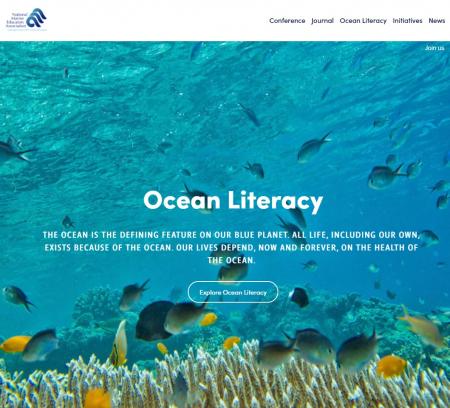ACTIONS
- Protect and safeguard cultural and natural heritage
- Learning and educational opportunities
- Cultural participation/social inclusion
- Sustainable tourism
- Support research
- Employment (recruiting, training, safety)
- Energy consumption, greenhouse gas emissions
- Waste management and reduction
- Transport (forms of, energy use)
- Commercial activities including copyright and IP
- Governance and management
- Security, disaster preparedness, risk reduction
- External partnerships and collaborations
- Publication/report
- Toolkit/framework/roadmap
- Sign-post to other resource (database)
- Case studies
- Training course
- Video
Ocean Literacy Framework

Intended Audience
Students, educators, and anyone interested in the ocean and people’s relationships with it.
- National Marine Educators’ Association
“The Ocean Literacy Framework comprises the Ocean Literacy Guide, the Ocean Literacy Scope and Sequence for Grades K–12, and the Alignment of Ocean Literacy to the Next Generation Science Standards (NGSS). This 3-part framework presents a vision of an ocean-literate society and outlines the knowledge required to be considered ocean literate.”
Avaiable in
- English
SDGs LINKAGES
The 7 principles and the resource help support a number of SDG targets linked to education, including 4.4 (staff training), 4.7 (Education for Sustainable Development), 11.4 (protecting cultural and natural heritage), 12.8 (lifestyles in harmony with nature), 13.3 (climate change education and awareness), 14.1 (reducing pollution), 14.2 (safeguarding marine ecosystems and coasts) and 15.5 (protecting species and preventing extinctions).
Click on the SDG Target to discover Our Collections Matter indicators
-
Our Collections Matter indicators:
- Number of young people and adults in skills-development activities and programmes drawing on collections, for employment, decent jobs and entrepreneurship.
- Increase in number of young people and adults in such programmes.
- Number and proportion of staff who have received training in the last year, to better support their contribution to the SDGs.
- Programs and processes in place to ensure the availability of a skilled workforce.
-
Our Collections Matter indicators:
- Numbers of people in each type of programme drawing on collections from different demographic groups.
- Increases in numbers of people in each type of programme from different demographic groups.
- Proportion of people involved in such programmes in relation to overall audience size.
- Evidence that learners have acquired knowledge and skills to promote sustainable development.
-
Our Collections Matter indicators:
- Total expenditure (public and private) per capita spent on the preservation, protection and conservation of all cultural and natural heritage, by type of heritage.
- Plans, policies and procedures in place for the safe use of collections for a variety of purposes, protecting and safeguarding both collections and those who use them.
- Plans, policies and procedures in place for the identification, safeguarding and protection of cultural and natural heritage at risk.
- Collecting programmes in place to protect, safeguard and make use of cultural and natural heritage, addressing the needs of communities and stakeholders, and ensuring that collections can be an effective resource for sustainable development.
- Number and diversity of educational, awareness-raising, research programmes, and partnerships that aim to strengthen protection of cultural and natural heritage.
-
Our Collections Matter indicators:
- Extent to which (i) global citizenship education and (ii) education for sustainable development (including climate change education) are mainstreamed in (a) national education policies; (b) curricula; (c) teacher education; and (d) student assessment.
- Extent to which global citizenship education and education for sustainable development (including climate change education) are mainstreamed in formal, informal and non-formal education programmes and activities drawing on and related to collections.
-
Our Collections Matter indicators:
- Plans in place to enhance positive contributions to addressing climate change through use of collections. Plans in place to ensure collections, collections institutions and broader society can adapt effectively to climate change.
- Plans in place for effective education and awareness raising on climate change mitigation, adaptation, impact reduction and early warning.
- Plans in place to reduce negative contributions of collections-related functions, e.g. measuring greenhouse emissions with plans and targets in place to reduce them.
-
Our Collections Matter indicators:
- Number of collections-related programmes, for example research and education, that aim to reduce marine pollution.
- Quantity, and reduction, of waste of all sorts, with plans in place to eliminate waste of all sorts as soon as possible.
- Quantity, and reduction, of plastic waste, with plans in place to eliminate the production and release of plastic waste as soon as possible.
-
Our Collections Matter indicators:
- Proportion of marine and coastal areas in a good ecological condition.
- Numbers of educational and awareness-raising programmes, research activities, and partnerships drawing on collections aiming to support protection of marine and coastal areas.
-
Our Collections Matter indicators:
- Number and proportion of habitats, notably endangered habitats, and species with favourable conservation status, with special reference to locally, nationally and globally endangered species.
- Information on, programmes relating to, collections development, and partnerships relating to habitats and species drawing on collections in place, to support their protection and continued existence.
- Measures taken to enhance biodiversity value of green space associated with collections institutions.
